My brothers, Tom and Bob with Sati, the Amah, in the garden at Meteor Road, Tengah
The great bard said “If music be the food of love – play on”. For me it was more a case of “Love the food – let the music play on”. Singapore food was and still is famed for its variety, quality and taste. You can find every taste of the globe in Singapore. It was a family ritual to go to the families club overlooking Changi airfield every Sunday for lunch. For the first few weeks, as my brothers and I were fairly young and unadventurous with food, it was egg and chips with lashings of tomato sauce. Each week our parents would try to persuade us to try something from the Asian food part of the menu. Each week we steadfastly refused and ordered egg and chips. I was the first to give in and was persuaded to try the special fried rice. There was ham, chicken and prawns in it. After the first mouthful I thought “wow, why have I been so silly and been insisting on egg and chips all these weeks”. I would like to say that I branched out into all sorts of dishes, but no, fried rice was safe and I stuck with that for some time. Eventually I did get more adventurous and started to work my way down the menu.
The great bard said “If music be the food of love – play on”. For me it was more a case of “Love the food – let the music play on”. Singapore food was and still is famed for its variety, quality and taste. You can find every taste of the globe in Singapore. It was a family ritual to go to the families club overlooking Changi airfield every Sunday for lunch. For the first few weeks, as my brothers and I were fairly young and unadventurous with food, it was egg and chips with lashings of tomato sauce. Each week our parents would try to persuade us to try something from the Asian food part of the menu. Each week we steadfastly refused and ordered egg and chips. I was the first to give in and was persuaded to try the special fried rice. There was ham, chicken and prawns in it. After the first mouthful I thought “wow, why have I been so silly and been insisting on egg and chips all these weeks”. I would like to say that I branched out into all sorts of dishes, but no, fried rice was safe and I stuck with that for some time. Eventually I did get more adventurous and started to work my way down the menu.
Old photo of food stall in Bugis Street; courtesy of (Memories of Singapore)
Once a week, one of the restaurants in Changi Village made curry puffs, a parcel of curried minced meat in puff pastry. Curry was something that we had experienced back home in the UK; you know the fairly mild stuff with apple and raisins in it. We quickly adapted to the stronger taste and heat of real curry and the curry puffs were a regular favourite. After a few months in Singapore, my father instituted a family tradition of going into the city on the first Sunday of each month. It was always fairly predictable, taxi in to the Union Jack club and we boys would spend a couple of hours in the swimming pool being fed Cocoa Cola when we got thirsty. Dad of course, would be slaking his thirst with Tiger or Anchor beer. After the pool we would then go to the Islamic restaurant on Beach Road. It was here that we were introduced to Indian curry. I have to admit I was a bit worried at the thought of possibly a very hot curry and went into defensive mode. “Do they have fried rice?” I asked. “Well sort of” my father replied, “ but it’s a little bit different to Chinese fried rice and it is called Briyani”. A little fearfully I said, “OK I’ll have a prawn Briyani”. Brother Tom followed suit and after a bit of humming and hawing Bob agreed to try it as well.
The food arrived and “Wow” Mum and Dad had ordered chicken curry of some sort and we were given side dishes of boiled egg, mango pickle, pineapple, peanuts and shreds of coconut. The three dishes of Briyani arrived with their dishes of curry sauce. The table was groaning under the weight of it all. The taste was absolutely out of this world. I had never tasted anything like it before in my life. The combination of spices, the fresh prawns and the flavoursome rice was the epitome of perfection. Instant conversion, even to this day, Prawn Briyani is one of my favourite dishes. I’m drooling at the thought of it even now almost fifty years later.
Curry now became a regular part of our diet. My mother even sent a recipe back to her friend in the UK who had originally given her the recipe for curry with raisins and apple in it. She included several side notes in it like, “Yes that really is dessert spoons and not teaspoons”, and a warning “You’ll find that it has a very warming sensation.”
Food seemed to be an integral part of being in Singapore. In fact one thing that you are often asked is not, “How are you?” but “Have you eaten yet?” As you walked along the five foot way you would often come across somebody sat with a clay pot charcoal barbecue cooking sticks of Satay. Satay is another of the wonderful dishes of Asia. Meat is marinated in a spicy sauce with chillies, ginger, lemon grass to name but a few of the ingredients and served with a spicy sauce containing coarsely ground roast peanut. As darkness fell, Changi Village would come alive with hawker stalls. Often the self-contained stall was built around a tricycle making it extremely mobile. They would be lit with a paraffin fuelled Tilley lamp. The most popular dish seemed to be noodles, which of course came in all sorts of shapes and sizes.
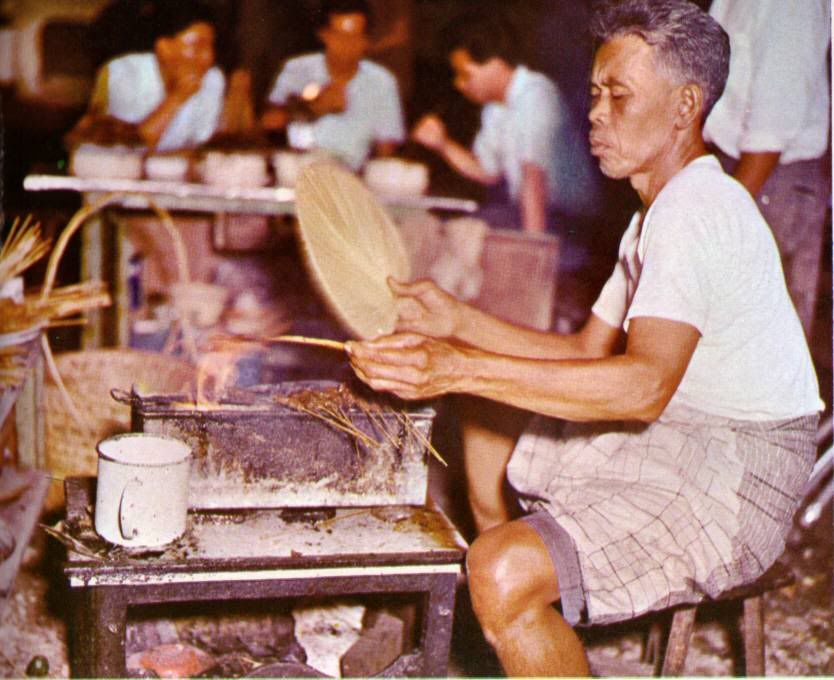
Photo of a satay stall of old; courtesy of (Memories of Singapore)
Food arriving on bicycle wheels seemed to be a normal part of everyday life. The Magnolia ice cream man would arrive, park his bike on the stand, one of those pull-down jobs on the back wheel that lifted the back wheel off the ground. The ice cream was in an insulated box mounted on the carrier over the back wheel. He would ring his hand bell as soon as he had parked his bike and be surrounded by mothers and children seeking to purchase his wares. Inside the insulated box must have been like a timelord’s Tardis because there were family sized blocks, wafer blocks in a variety of favours, and ice lollies, milky strawberry or plain milky, blackcurrant, strawberry and even Durian ice lollies.
Durian is a fruit that I can only describe as an acquired taste that I never managed to acquire just as I have never acquired a taste for some of the riper cheeses. To me the smell of the fruit was like an open sewer. Even on returning to the east several times over the intervening years, I find that I just cannot get my nose past that smell despite trying several times. It has been described as having the smell of a drain but a taste like heaven. It is a highly prized fruit for Asians and it is a great compliment to be offered a slice. I found that I had to mentally close my nostrils and try to keep them closed whilst I ate the fruit. It never really worked and it is probably the only fruit that I have never taken to despite my best efforts. My brother Bob however quite liked durian. His work often took him to Asia, (lucky man), and he used to tell the tale of how he once bought a couple of durians and walked through Robinsons department store. By the time he left the store, there were six female sales assistants following him and the aroma of his durians.
Fruit of course was another food that arrived on bicycle wheels. The fruit seller was known as Mary and she had an amazing variety of fruit for sale. There were pineapples, apples and oranges, mangosteens and my particular favourite rambutan. The rambutan is related to the Lychee but the skin has long hairy like protrusions that give it its name, as rambut is Malay for hair. This might sound a little off-putting but the red skin peels away easily just as if you were peeling a thick skinned orange and then inside you find what looks a little bit like a white plum. The white fruit covers a stone. Biting into the fruit it is juicy, fragrant and sweet without being excessively sour. Describing the fragrance is difficult and all I can say is that it is rambutan. If pressed I would describe it as floral, sweet maybe a hint of lavender, maybe a hint of orange but only the vaguest hint as the fragrance is so subtle. This might all sound a bit pretentious or even a bit wine buff, but I can only say; well that’s rambutans and I love them and I would gladly pay the air fare to go back and taste them again and again if only I could afford it.

Having mentioned Mary I must digress from the topic of food and in doing so I make no apologies as I am raising a very interesting and important point. Mary was an extremely exceptional lady, not only did she give rambutans to the children who patronised her stall, which in my book made her pretty special, she had also been awarded the O.B.E. She was really a special lady, as some of the prisoners of war in Changi Prison will testify. She played an important part in helping escaped prisoners and it was for this that she was warded the O.B.E. On the return to British rule, she was granted the freedom to sell her fruit anywhere on the military bases at Changi. I know this is only a short paragraph but Mary probably merits a whole book to herself and I hope that somebody will do the research one day on a topic that will reward the researcher tenfold.
So having made that important digression from the subject of food let us return to the topic in hand. I was going to say that one of the strangest fruit was the Pomello but there are probably other candidates with equal provenance to the claim. Anyway, the Pomello was a fruit we tried and it was a citrus fruit about the size of a melon that was like a cross between a grapefruit but not as bitter, and a fragrance with a hint of orange. The flesh inside was segmented in a typical citrus fashion but inside the segments the soft bead like structure of an orange or lemon was a bit more fibrous and you could remove little sachets of fruity, juicy material and pop them in your mouth one by one.
I mentioned Mangosteens earlier, the skin is semi-hard and purple and likely to stain whatever it comes into contact with. The flesh inside once again is juicy and distinctive, impossible to liken to anything from Europe. All I can say is, travel to the Far East and try for yourself.
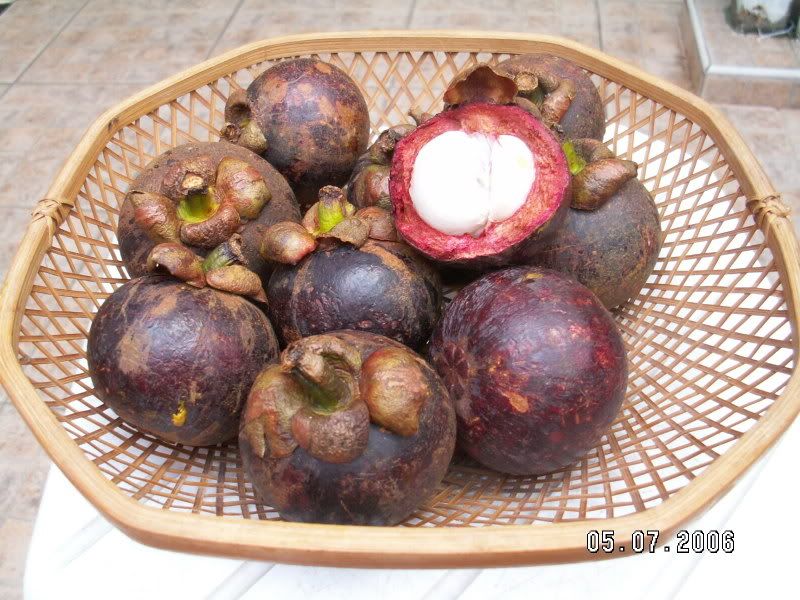
To correct any impression you might have that life was one exotic eating orgy (maybe it was) the amah used to prepare what we consider as perfectly normal English dishes. Her repertoire included egg and chips, mince and mash, pork chops with peas and mash as well as the exotic dishes like curry. Sunday roasts were very rare though as it was the amah’s day off and we usually went to the families club for lunch (special fried rice).
Singapore changed my outlook on food. Rice was no longer a dish that was served as a sweet pudding. Rice had a thousand and one possibilities; it also came in many varieties although at this time I was only able to differentiate two types, short grain for rice puddings and long grain for savoury dishes. Nowadays I prefer boiled rice to boiled potatoes but I do have to admit that any form of fried potato is almost equal to any form of rice, boiled, fried or risotto. The one exception to this would be “congee” or rice porridge. It’s a nice non-irritant dish when you have diarrhoea but it has nothing else much to commend it although the Tanjong Pagar area of Singapore is noted for it where it is served with all sorts of extras (it needs it).
It was almost impossible to avoid soggy breakfast cereals with the high humidity and we very quickly adapted to the Australian version of Weetabix called Weet Bix. The biscuit was a lot harder and seemed very resistant to humidity problems. Fresh milk was virtually unheard of and so powdered milk (KLIM) was the norm. We had a special mixer for making up the milk. A tall glass cylinder was three quarter filled with water from the refrigerator, powdered milk added and then a plunger with perforations in the disc introduced into the cylinder to push the powdered milk up and down to get it to wet out and dissolve. It required several minutes of vigorous pumping to get all the powder to dissolve.
As well as the all time favourites Coca Cola and Pepsi Cola a whole range of soft drinks were available at the NAAF and swimming pool including Ice Cream Soda, Sarsaparilla, Lemonade, Orangeade, Cherryade and Ginger Beer. Ice cream soda was nice with a scoop of ice cream in it and was known as an Ice Cream Soda float. Other favourites at the pool were the Coconut Ice slabs and my good friend Raymond Clayton reminded me recently that you could also get giant pickled onions at the pool. I met up with Raymond 40 years after we had been in Singapore after bumping into his elder brother at a Singapore schools reunion that was held in London. The reunion is also a chance to relive the food as the group usually goes on to Soho for a Chinese meal.
I’m also pleased to say that I still enjoy food in Singapore whenever I have made visits related to my work. I am a fan of the food courts and hawker stalls. Early childhood influences have certainly their mark on my food preferences.
….. To be continued.
Here are some photos of a Pomelo farm in Tambun, near Ipoh, Perak, Malaysia. I visited this farm last year with my family. – Lam Chun See
Picture No. 1 – This is view of the pomelo farm. The pomelo trees are in the background. The farmers also plant vegetables to supplement their income.
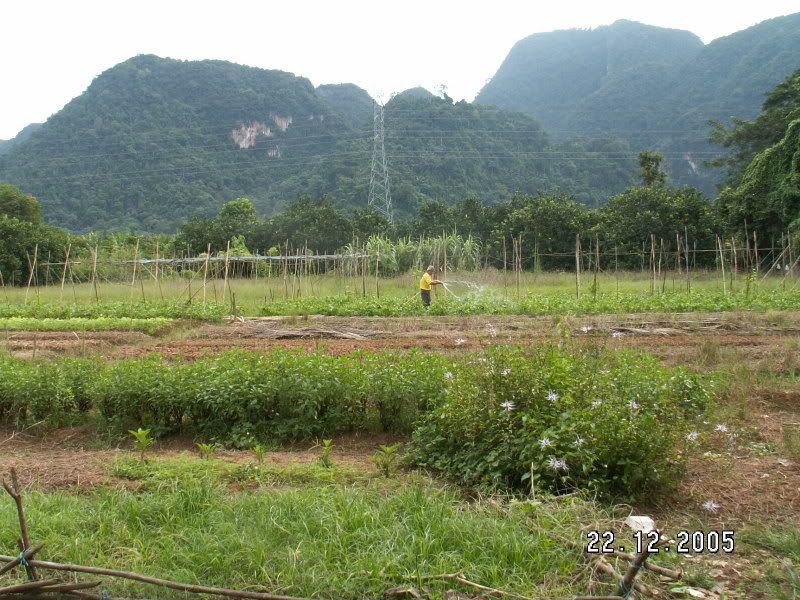
Picture No. 2 – My 3 children and their cousins posing in front of a cluster of pomelo trees. Did you know that each tree can produce up to 200 fruits?
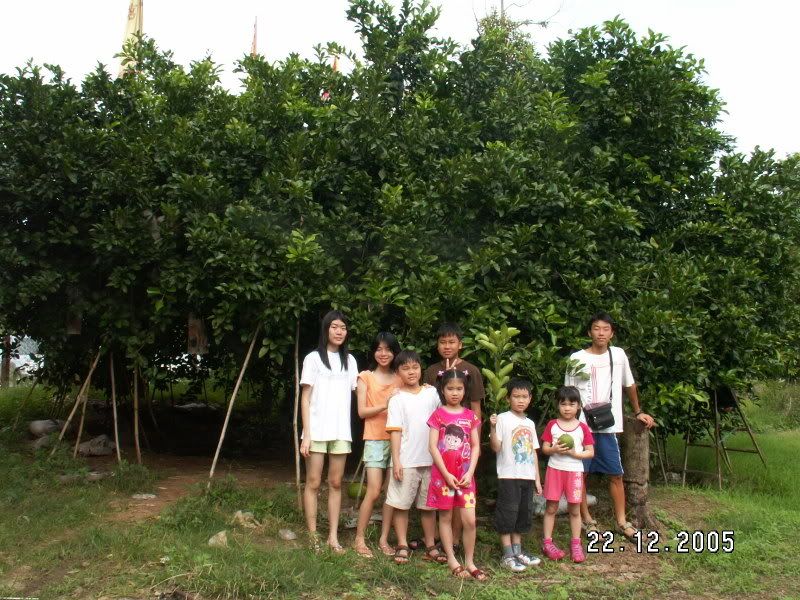
Picture No. 3 – Here’s a picture of a pomelo that not many Singaporean kids are familiar with.
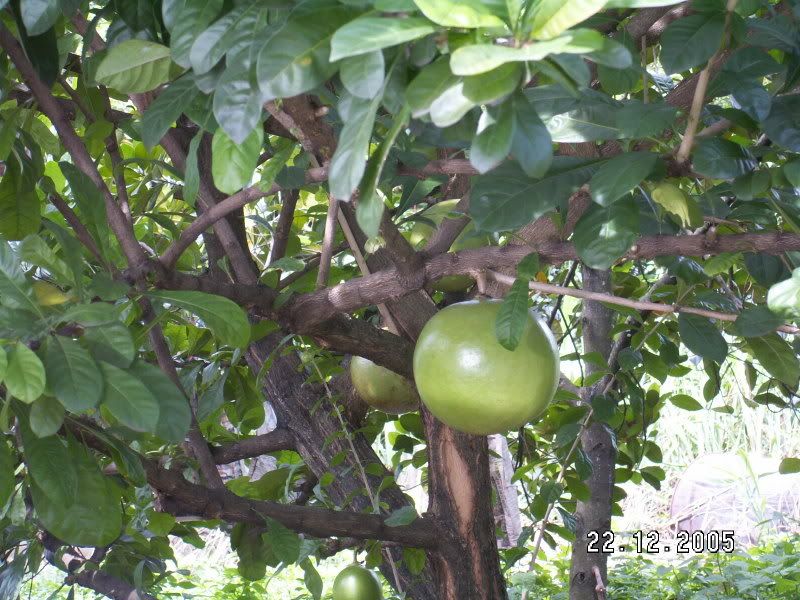
Durian is a fruit that I can only describe as an acquired taste that I never managed to acquire just as I have never acquired a taste for some of the riper cheeses. To me the smell of the fruit was like an open sewer. Even on returning to the east several times over the intervening years, I find that I just cannot get my nose past that smell despite trying several times. It has been described as having the smell of a drain but a taste like heaven. It is a highly prized fruit for Asians and it is a great compliment to be offered a slice. I found that I had to mentally close my nostrils and try to keep them closed whilst I ate the fruit. It never really worked and it is probably the only fruit that I have never taken to despite my best efforts. My brother Bob however quite liked durian. His work often took him to Asia, (lucky man), and he used to tell the tale of how he once bought a couple of durians and walked through Robinsons department store. By the time he left the store, there were six female sales assistants following him and the aroma of his durians.
Fruit of course was another food that arrived on bicycle wheels. The fruit seller was known as Mary and she had an amazing variety of fruit for sale. There were pineapples, apples and oranges, mangosteens and my particular favourite rambutan. The rambutan is related to the Lychee but the skin has long hairy like protrusions that give it its name, as rambut is Malay for hair. This might sound a little off-putting but the red skin peels away easily just as if you were peeling a thick skinned orange and then inside you find what looks a little bit like a white plum. The white fruit covers a stone. Biting into the fruit it is juicy, fragrant and sweet without being excessively sour. Describing the fragrance is difficult and all I can say is that it is rambutan. If pressed I would describe it as floral, sweet maybe a hint of lavender, maybe a hint of orange but only the vaguest hint as the fragrance is so subtle. This might all sound a bit pretentious or even a bit wine buff, but I can only say; well that’s rambutans and I love them and I would gladly pay the air fare to go back and taste them again and again if only I could afford it.

Having mentioned Mary I must digress from the topic of food and in doing so I make no apologies as I am raising a very interesting and important point. Mary was an extremely exceptional lady, not only did she give rambutans to the children who patronised her stall, which in my book made her pretty special, she had also been awarded the O.B.E. She was really a special lady, as some of the prisoners of war in Changi Prison will testify. She played an important part in helping escaped prisoners and it was for this that she was warded the O.B.E. On the return to British rule, she was granted the freedom to sell her fruit anywhere on the military bases at Changi. I know this is only a short paragraph but Mary probably merits a whole book to herself and I hope that somebody will do the research one day on a topic that will reward the researcher tenfold.
So having made that important digression from the subject of food let us return to the topic in hand. I was going to say that one of the strangest fruit was the Pomello but there are probably other candidates with equal provenance to the claim. Anyway, the Pomello was a fruit we tried and it was a citrus fruit about the size of a melon that was like a cross between a grapefruit but not as bitter, and a fragrance with a hint of orange. The flesh inside was segmented in a typical citrus fashion but inside the segments the soft bead like structure of an orange or lemon was a bit more fibrous and you could remove little sachets of fruity, juicy material and pop them in your mouth one by one.
I mentioned Mangosteens earlier, the skin is semi-hard and purple and likely to stain whatever it comes into contact with. The flesh inside once again is juicy and distinctive, impossible to liken to anything from Europe. All I can say is, travel to the Far East and try for yourself.

To correct any impression you might have that life was one exotic eating orgy (maybe it was) the amah used to prepare what we consider as perfectly normal English dishes. Her repertoire included egg and chips, mince and mash, pork chops with peas and mash as well as the exotic dishes like curry. Sunday roasts were very rare though as it was the amah’s day off and we usually went to the families club for lunch (special fried rice).
Singapore changed my outlook on food. Rice was no longer a dish that was served as a sweet pudding. Rice had a thousand and one possibilities; it also came in many varieties although at this time I was only able to differentiate two types, short grain for rice puddings and long grain for savoury dishes. Nowadays I prefer boiled rice to boiled potatoes but I do have to admit that any form of fried potato is almost equal to any form of rice, boiled, fried or risotto. The one exception to this would be “congee” or rice porridge. It’s a nice non-irritant dish when you have diarrhoea but it has nothing else much to commend it although the Tanjong Pagar area of Singapore is noted for it where it is served with all sorts of extras (it needs it).
It was almost impossible to avoid soggy breakfast cereals with the high humidity and we very quickly adapted to the Australian version of Weetabix called Weet Bix. The biscuit was a lot harder and seemed very resistant to humidity problems. Fresh milk was virtually unheard of and so powdered milk (KLIM) was the norm. We had a special mixer for making up the milk. A tall glass cylinder was three quarter filled with water from the refrigerator, powdered milk added and then a plunger with perforations in the disc introduced into the cylinder to push the powdered milk up and down to get it to wet out and dissolve. It required several minutes of vigorous pumping to get all the powder to dissolve.
As well as the all time favourites Coca Cola and Pepsi Cola a whole range of soft drinks were available at the NAAF and swimming pool including Ice Cream Soda, Sarsaparilla, Lemonade, Orangeade, Cherryade and Ginger Beer. Ice cream soda was nice with a scoop of ice cream in it and was known as an Ice Cream Soda float. Other favourites at the pool were the Coconut Ice slabs and my good friend Raymond Clayton reminded me recently that you could also get giant pickled onions at the pool. I met up with Raymond 40 years after we had been in Singapore after bumping into his elder brother at a Singapore schools reunion that was held in London. The reunion is also a chance to relive the food as the group usually goes on to Soho for a Chinese meal.
I’m also pleased to say that I still enjoy food in Singapore whenever I have made visits related to my work. I am a fan of the food courts and hawker stalls. Early childhood influences have certainly their mark on my food preferences.
….. To be continued.
Here are some photos of a Pomelo farm in Tambun, near Ipoh, Perak, Malaysia. I visited this farm last year with my family. – Lam Chun See
Picture No. 1 – This is view of the pomelo farm. The pomelo trees are in the background. The farmers also plant vegetables to supplement their income.

Picture No. 2 – My 3 children and their cousins posing in front of a cluster of pomelo trees. Did you know that each tree can produce up to 200 fruits?

Picture No. 3 – Here’s a picture of a pomelo that not many Singaporean kids are familiar with.

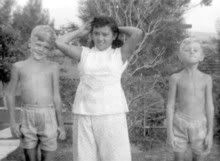






17 comments:
"Durian is a fruit that I can only describe as an acquired taste that I never managed to acquire.."
Ahh .. John, John ..... this has to be the saddest statement from you so far. Sim Wong Hoo, our famous entrepreneur, founder of Creative Technology actually devoted one section of his book to advise foreigners how to enjoy the King of Fruits. The secret, he says, is to attempt it twice in a row. The first time, you might hate it. But after the 2nd time, you'll hooked for ever.
I cannot fathom how one cannot like, correction - love durians! *sigh*
It's by far one of the best tasting treats that nature has to offer us. Nothing else comes even close.
I LOVE durians! And am so happy that the durians season is just starting in Kuching. Keeping my fingers closed that it would be a long and bountiful season! :)
fh20 - you really phrased it well. Comparing taste of rambutans to durians, is like comparing English or Japanese curry with the Indian curry in Serangoon Road.
Sadly, I never got to try the Sarawak durians. On the few ocassions that I had the opportunity, I restrained myself becos I was on teaching assignment and was worried about what the 'heat' would do to my throat.
I'm drooling drooling drooling.
Give me my curry, now!
On the taste of Durians I do have to admit that I was given a specially selected Durian when my wife and I were driving across the top of Malaysia near the Thai border in 1998 and that I didn't find it all that bad. I guess a few more tries might eventually get me to the point where I like it.
John H.
Hi everyone. David, another 'Brit' has shared some of his experience here. Like John, David loves Spore.
David, hope you are reading this comment. All the best to your book project. Pls let me know if I can help to pubicize your book on this blog. Better still, share a extract with us. Especially we would like to see your photos.
Durian - you either hate it or you love it - there's no in between. As to whether the taste for it is acquired or in-born, nature or nurture, well that is debatable.
I personally luuurve durians but I also believe that food which is tasty and delicious is bad for your health. And at my age (above 50), I can't be taking so much risk all the time. No choice but to eat in moderation.
The durian which we very affectionately proclaim as 'the King of Fruits', is a very special fruit in that every fruit you taste (in one eating session) has a different texture and taste to it. I believe that the variety that John tried near the Thai border is the Thai variety which is milder, sweeter and less fragant (or smelly, depending on which camp you are from). It's like comparing XO liquor with beer. Can't compare.
Hi John, thanks for sharing your stories with us. As Chun See said, you offer a 'unique perspective' and it is very educational for us.
You strike me as quite adventurous type. I mean taking to curry and nasi briyani so quickly. Hence I am quite surprised that you did not overcome the initial distaste for durians. I have friends from Japan and Hong Kong, who are much less adventurous than you, foodwise, yet they fell in love with the durian.
I am also a big fan of Nasi Briyani. I am just wondering if the Islamic Restaurant that John spoke about in Beach Rd is still around. Probably not - almost half a century has gone by already.
John - do you like Roti Prata?
"By the time he left the store, there were six female sales assistants following him and the aroma of his durians."
- It proves that the aroma of the durians is more seductive than the fragance of the muskiest perfume.
John mentioning of Nasi Briyani, especially the one from Islamic Restaurant, makes my mouth waters. In fact during my wedding celebration I catered two tables of Nasi Briyani with related food items from Islamic Restaurant itself for my Muslim friends. During the early years, we used to gather at a coffee shop (lunch time), Nelson Road (Old PSA Gate No. 5), which served great Briyani dish, once a week (either mutton or chicken). Clearly the stall owner knew that we were 'hooked onto' his Briyani, increased his selling price gradually & painlessly, ten cents a week, until such time when we started to complain. Another local Indian curry dish that has a 'knock-out' punch, is none other than the famous fish-head curry. According to my Indian friends, this dish is concocted by local Indians most likely in the earlier years. It has no equivalents in India itself. Later on a gentleman by the name of Sebastian Gomez cooked up a fiery curry fish-head 'storm' and named his dish after his name. This is just a tip of the (iceberg)food chain in Singapore. We need more discussion on Singapore famous past-time indulgence - EATING.
I wonder if it is difficult to get the tropical fruits that John mentioned in the UK? I once saw a durian on sale in Tokyo. If I remember correctly (it was a long time ago), it cost nearly S$100!!!
Indian Fish Head Curry? Was this at the old Selegie House (in the 60s) at some ground-floor coffee-shop?
Was introduced to the dish by my father. The guys used to operate from a bungalow house at Wilkie Road (behind the Peace Center) before he moved to Selegie House. I tried the mutton balls also.
Actually thanks and no thanks to Sebastian Gomez, I landed in hospital - Middleton to be exact. That was where I sat for my A levels in hospital.
Wonder what happened to Sebastian Gomez? I want to personally thank him.
Peter you are right. I heard that the founder operated from the Selegie area but I ate it at the branch outlet at Outram Park complex, nearer to my place of work. On one occasion I saw a young lady polished up a large fish-head herself. I was wondering that she must have a terrific appetite. Sebastian concocted his niche dish by making it extra hot, perhaps with no quality control, that was why many could not take it. You could be one of them. On one occasion I happened to taste a rather diluted version and queried the waiter. He replied that Sebastian had gone on holidays in India. I think by now he could be happily enjoying his retirement in India after his successful business venture in Singapore.
Some British Servicemen also liked NASI GORENG. Vey Cheap! $1.00 a plate I was told.
Has anybody tried the Indian Fish Curry over in Johore Bahru at City Square? 1/2 a head cost M$22/-. I took a bus in and bought out 2 fish heads for dinner. BEST!!!!
Peter, next time can "ta pao" (= takeaway) half a fish head for me? Since you also stay in the east part of Singapore, I can just pick it up from you. Just give me a tinkle, haha.
I remember that beef kway teow stall in Bugis Street featured in the photo. I used to stay at Cheng Yan Place, which was just across the road from Bugis Street. My mum used to send me there to buy supper for the family. There were two beef kway teow stalls facing each other in Bugis Street. Each bowl sold for only 30 cents at that time.
I seem to have stirred up some discussion here. I guess that was inevitable on the topic of food. Chun See asked availability of Singapore fruits in the UK. I have seen Rambutans and Lychees on sale in some of the supermarkets but not very often and as they were expensive and the hairs on the Rambutans had lost their springiness I decided not bother buying and just live the taste in my mind until I could go back to get the real thing fresh.
Chuck asked about the Islamic Restaurant. Here is a photo I took of it in 1998. So it was still going strong then. I think that I also saw it when I was last along Beach Road in 2002 but wouldn't swear to it. Perhaps you Singapore guys can tell us.
John Harper
Post a Comment